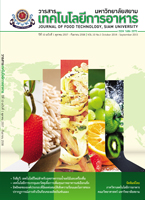การใช้แป้งกล้วยหอมทองดิบที่มีสมบัติต้านทานการย่อยสลายด้วยเอนไซม์ในผลิตภัณฑ์พาสต้า
Main Article Content
Abstract
งานวิจัยนี้มีวัตถุประสงค์เพื่อพัฒนาผลิตภัณฑ์อาหารจากแป้งกล้วยดิบที่มีสมบัติต้านทานการย่อยสลายด้วยเอนไซม์ (Resistant starch; RS) โดยแปรผันแป้งกล้วยดิบ 3 ชนิด คือ แป้งกล้วยน้ำว้าดิบ (อายุ 14–16 สัปดาห์หลังแทงปลี) แป้งกล้วยหอมทองดิบ (13–15 สัปดาห์หลังแทงปลี) และแป้งกล้วยไข่ดิบ (6–8 สัปดาห์หลังแทงปลี) จากการศึกษาปริมาณ RS และสมบัติทางเคมีกายภาพ พบว่า แป้งกล้วยหอมทองดิบ มีปริมาณ RS สูงกว่าแป้งกล้วยไข่ดิบและแป้งกล้วยน้ำว้าดิบ ปริมาณอะมิโลสมีค่าสูงอยู่ระหว่างร้อยละ 38.33-44.67 แต่ร้อยละการละลายไม่มีความแตกต่างกันอย่างมีนัยสาคัญทางสถิติ (p≤0.05) ส่วนกาลังการพองตัวมีค่าต่ำอยู่ระหว่าง 6.12–7.92 เท่า จากนั้นคัดเลือกแป้งกล้วยหอมทองดิบที่มีปริมาณ RS สูงสุด มาผลิตพาสต้า โดยแปรปริมาณแป้งกล้วยหอมทองดิบทดแทนเซโมลินาบางส่วน ที่ระดับร้อยละ 0 (สูตรควบคุม), 15, 30 และ 45 (โดยน้าหนักแป้ง) ผลการทดลองพบว่า ผลิตภัณฑ์มีค่าความสว่าง (L*) และค่าสีเหลือง (b*) ลดลงตามปริมาณแป้งกล้วยหอมทองดิบที่มากขึ้น ค่า Hue (o) อยู่ระหว่าง 73.51-82.92 ซึ่งแสดงสีส้มแดง-สีเหลือง และพาสต้าที่ใช้แป้งกล้วยหอมทองดิบ ร้อยละ 45 มีค่า E สูงสุดเมื่อเทียบกับสูตรควบคุม ค่า Cooking yield อยู่ในช่วงร้อยละ 215.70–225.17 และจากการศึกษาองค์ประกอบทางเคมีของผลิตภัณฑ์พบว่า พาสต้าจากแป้งกล้วยหอมทองดิบทดแทนเซโมลินามีปริมาณเส้นใย และเถ้าเพิ่มขึ้น เมื่อเทียบกับสูตรควบคุม พาสต้าจากแป้งกล้วยหอมทองดิบทดแทนเซโมลินาบางส่วนทุกสูตร มีปริมาณกลูโคสที่ได้จากการย่อยสลายด้วยเอนไซม์ต่ำกว่าสูตรควบคุม โดยพาสต้าจากแป้งกล้วยหอมทองดิบสูตรทดแทนร้อยละ 45 ถูกย่อยสลายได้กลูโคสปริมาณต่ำที่สุด
Application of Resistant Starch from Unripe Banana “Hom Thong” (Musa sapientum L., AAA group) in Pasta
The aim of research was conducted to develop food product from unripe banana flour that had the enzymatic resistant starch property. The experiment was varied unripe banana flour on three cultivars, Kluai Namwa (14-16 weeks after stabbing banana blossom), Kluai Hom Thong (13-15 weeks after stabbing banana blossom), Kluai Khai (6–8 weeks after stabbing banana blossom). Resistant starch (RS) content and physicochemical properties of unripe banana flours were analyzed. Results found that RS content of unripe Hom Thong banana flour was higher than that of unripe Namwa and Khai banana flour. The amylose content of these flours were high, between 38.33-44.67%; however, the solubility were not significantly different (p<0.05) and swelling power were low (between 6.12-7.92). Unripe Hom Thong banana flour had the highest RS content; therefore, it was selected to produce pasta. Unripe Hom Thong banana flour was partly used to substitute semolina at 0 (control), 15, 30 and 45% (by flour weight). Color measurement results showed that L* and b* value decreased when increasing unripe Hom Thong banana flour. Hue (o) was between 73.51-82.92 (orange red orange red orange redorange redorange red -yellow yellowyellowyellow color) and pasta that substituted with Hom Thong banana flour at 45% had the highest E. Cooking yield was between 215.70–225.17%. The chemical composition analysis showed that Hom Thong banana pasta had high fiber and ash content than those of control. All of Hom Thong banana pasta had lower glucose content (mg/100 g starch) from enzymatic hydrolysis than control and pasta that substituted with Hom Thong banana flour at 45% was the lowest in the glucose content.
Article Details
Copyrights of all articles in the Journal of Food Technology available in print or online are owned by Siam University and protected by law.


